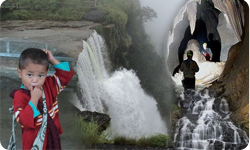Tourism Of Meghalaya

Home to most of the deepest and longest caves in South Asia, Meghalaya is blessed with spectacular scenic beauty, flora, fauna, thick forests, large rivers, forest groves and grass fields – making it a captivating tourism destination.
Number of tourists visiting Meghalaya was 725,000 in 2014-15. This was an increase of 4.76 per cent over the previous year. Of these 99 per cent were domestic, only 1 per cent was foreign tourists.
Under the Budget 2015-16, the state government of Meghalaya allocated US$ 17.75 million for the development of the tourism sector. Thanks to the abundance of medicinal plants, the state will endeavour to promote herbal tourism. Besides the state government will focus on adventure activities including parasailing, zip lining, kayaking, mountain cycling, rock climbing, etc., during 2015-16.
Under the 12th Five Year Plan, valid from 2012 to 2017, Meghalaya has been sanctioned US$ 25.3 million to develop tourism sector in the state.
Whether you come to marvel at the soaring mountains and pristine valleys, beautiful lakes or explore wildlife, release your adventure pursuits, Meghalaya will impress everyone. One of the most famous tourist attraction in Shilong, Ward’s Lake attracts visitors for its placid waters, Boating facilities are also available. Botanical Garden and Botanical Museum on the other side of the lake houses varieties of various plants.
Located opposite the All Saints Cathedral, one of the oldest churches in Shillong, the State Museum showcases the cultural and anthropological life of the tribes of Meghalaya.
Don Bosco Centre for Indigenous Cultures is home to seven storied museum exhibiting the rich history and cultural heritage of north eastern states of India. The skywalk offers a 360 degree view of the Shillong city. Elephant Falls, one of the most famous waterfalls in Meghalaya, is on the way to Cherrapunjee.
Also known as Butterfly Museum, Entomological Museum comes lauded as the only known museum in the country devoted to butterflies and moths.
The Shillong Golf Course is one of the oldest and best natural golf courses in the world and is Asia's second 18-hole natural golf course. Cherrapunjee is known for being the place which experiences the heaviest rainfall in the world. Some of the nearby waterfalls are Nohsngithiang (Mawsmai Falls), Nohkalikai Falls and Kynrem Falls.
The hot springs at Jakrem near Mawsynram are believed to posses medicinal and curative properties. Located 17 km from Shillong on the Guwahati- Shillong road, Umiam Lake is the largest artificial lake in Meghalaya. Also known as Bara pani Lake (big Water Lake), Umiam Lake is a faouvirite among the picnickers. The visitors coem here to indulge in fishing, boating and water sports.
Mawjymbuin or Mawjynram cave is located in Mawsynram. The Cave houses a massive stalagmite resembling a Shiva lingam over which water drops from a breast-shaped stone hanging from the ceiling above. 140 km from Shillong, Ranikor is a top destination for the anglers.
Located a distance of 90 km from Shillong near the India-Bangladesh border the picturesque village of Mawlynnong comes lauded as one of the cleanest village in India and attracts visitors for its rock formations and hiking trails. Mairang was the seat of power of U Triot Sing Syiem, ruler of Nongkhlaw. He fought valiantly against the British on April 4, 1829. You an find a beautiful memorial dedicated to him. 10 km from Mairang is Kyllang Rock, a several million years old rock of granite rises 5,400 ft above sea level.
Nongkhnum Island
After Majuli Island in Assam Nongkhnum Island is the second largest island in the Asia. 14 km from Nongstoin, the headquarters of West Khasi hills district, the Island is created by the bifurcation of Kyunshi River into the Namliang River and Phanliang River. Balpakram National Park in the South Garo Hills district is a wildlife destination which attracts lovers of fauna and flora. Located near the Simsang River and known as Dobahkolor Cave of Bats, the limestone caves of Siju houses some of India’s rarest bat species. Situated near the Tura Peak, Nokrek Biosphere in the Garo Hills is an accepted haven for the wildlife lovers.